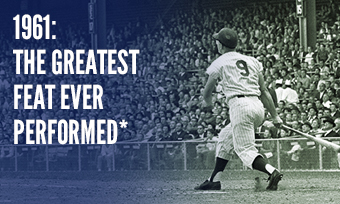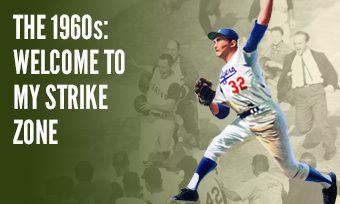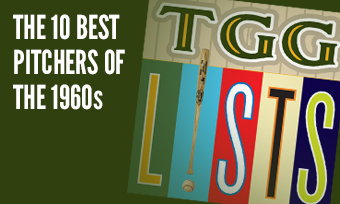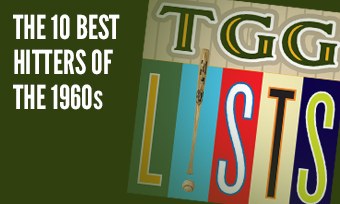The Yearly Reader
Leaders and Honors, 1961
Our list of baseball’s top 10 hitters and pitchers in both the American League and National League for the 1961 baseball season, as well as the awards and honors given to the game’s top achievers of the year.
The National League’s Top 10 Hitters, 1961
Bold type in brick red indicates league leader.
1. Frank Robinson, Cincinnati
Key Numbers: .323 average, 117 runs, 176 hits, 32 doubles, 7 triples, 37 home runs, 124 RBIs, 71 walks, 23 intentional walks, 10 sacrifice flies, 22 stolen bases, .611 slugging percentage.
He didn’t lead in any major offensive stat categories, but Robinson collectively had the best set of numbers to be found in the NL—and MVP voters perhaps noted that when making him the top choice.
2. Willie Mays, San Francisco
Key Numbers: .308 average, 129 runs, 176 hits, 32 doubles, 40 home runs, 123 RBIs, 88 walks, 18 stolen bases.
Bringing in the left-field fence at Candlestick Park certainly helped in pushing Mays’ home run totals to 40 for the first time since 1955, but a couple of impressive road contests—a four-homer game at Milwaukee and a three-homer game at Philadelphia—also provided some added power push.
3. Hank Aaron, Milwaukee
Key Numbers: 155 games, .327 average, 115 runs, 197 hits, 39 doubles, 10 triples, 34 home runs, 120 RBIs, 20 intentional walks, 21 stolen bases.
The future home run king was, for the moment, something more of a Ted Williams-like legend; over six years ending in 1961; no one in the NL batted higher than his .325 average.
4. Orlando Cepeda, San Francisco
Key Numbers: .311 average, 105 runs, 182 hits, 28 doubles, 46 home runs, 142 RBIs, 12 stolen bases.
Nearly doubling his home run output of a year earlier, Cepeda seemed more at ease when playing at his customary spot at first base (hitting .348 with 26 homers in 82 games at the position) than when shifted in the outfield to make room for hot young slugger Willie McCovey.
5. Ken Boyer, St. Louis
Key Numbers: .329 average, 109 runs, 194 hits, 26 doubles, 11 triples, 24 home runs, 95 RBIs.
Peaking at age 30, Boyer set a personal best for batting average and runs while hitting for his first of two career cycles.
6. Dick Stuart, Pittsburgh
Key Numbers: 138 games, .301 average, 83 runs, 160 hits, 28 doubles, 8 triples, 35 home runs, 117 RBIs, 121 strikeouts, 22 grounded into double plays.
The Pirates may have struggled in defense of their world championship, but an improved Stuart was not to blame. Still, Stuart’s 35 homers were far short of his professional peak of 66 for the Western League’s Lincoln Chiefs in 1956.
7. Wally Moon, Los Angeles
Key Numbers: 134 games, .328 average, 25 doubles, 17 home runs, 88 RBIs, 89 walks, .434 on-base percentage.
In his last solid year before the Dodgers’ move to pitching-friendly Dodger Stadium sapped him of his offensive confidence, Moon hit an astounding .382 with 14 homers in the team’s final year at the Los Angeles Memorial Coliseum.
8. Eddie Mathews, Milwaukee
Key Numbers: .306 average, 103 runs, 175 hits, 23 doubles, 6 triples, 32 home runs, 91 RBIs, 93 walks, 12 stolen bases.
Because of his keen eye at the plate—and because his name was Eddie, like so many others of the time who collected walks by the sackful—Mathews led the NL for the first of three straight years in bases on balls.
9. Vada Pinson, Cincinnati
Key Numbers: .343 average, 101 runs, 208 hits, 34 doubles, 8 triples, 16 home runs, 87 RBIs, 23 stolen bases.
Down the stretch, the in-the-shadows star hit .396 over his last 60 games to finish a not-so-distant second to Roberto Clemente in the NL batting race with a personal-best average.
10. George Altman, Chicago
Key Numbers: 138 games, .303 average, 28 doubles, 12 triples, 27 home runs, 96 RBIs.
With Ernie Banks’ power numbers beginning to soften and Billy Williams getting acclimated to the big-league scene, Altman best impressed on the Wrigley Field turf—and became the only left-handed batter ever to belt two homers in a game off the great Sandy Koufax.
The American League’s Top 10 Hitters, 1961
1. Mickey Mantle, New York
Key Numbers: .317 average, 131 runs, 163 hits, 16 doubles, 6 triples, 54 home runs, 128 RBIs, 126 walks, 12 stolen bases, .687 slugging percentage.
The Mick’s career-high 54 homers still weren’t enough to place first on his own team (Roger Maris), but one wonders how different things would have been had he not missed eight games after September 1 as late-season pains otherwise quelled his output.
2. Norm Cash, Detroit
Key Numbers: .361 average, 119 runs, 193 hits, 22 doubles, 8 triples, 41 home runs, 132 RBIs, 124 walks, 19 intentional walks, 11 stolen bases, .487 on-base percentage.
For his incredible spike of success, Cash thanked not so much expansion and additional games but a corked bat, as he would confess to using years later.
3. Jim Gentile, Baltimore
Key Numbers: .302 average, 96 runs, 25 doubles, 46 home runs, 141 RBIs, 96 walks, 11 hit-by-pitches.
Gentile, anything but with his frequent dugout tantrums, had little to pout about in his monster year; his five grand slams would set an AL standard lasting through 1987.
4. Rocky Colavito, Detroit
Key Numbers: 163 games, .290 average, 129 runs, 169 hits, 30 doubles, 45 home runs, 140 RBIs, 113 walks.
Colavito’s performance had Detroit fans chanting “we like steak”—a retort to the remarks of Frank Lane, the Cleveland GM who traded Colavito to Detroit for Harvey Kuenn in 1960 and, at the time, felt so good about the deal that “it was like trading hamburger for steak.”
5. Roger Maris, New York
Key Numbers: .269 average, 132 runs, 159 hits, 61 home runs, 141 RBIs, 94 walks.
Only batting in front of Mickey Mantle could allow Maris to launch 61 homers with no intentional walks.
6. Harmon Killebrew, Minnesota
Key Numbers: .288 average, 94 runs, 20 doubles, 7 triples, 46 home runs, 122 RBIs, 107 walks.
Unleashed in the Bloomington wilds, Killebrew hit the only inside-the-park homer of his career—this from a guy with 19 lifetime steals over 22 years.
7. Al Kaline, Detroit
Key Numbers: .324 average, 116 runs, 190 hits, 41 doubles, 7 triples, 19 home runs, 82 RBIs, 14 stolen bases.
All but lost within the statistical euphoria whipped up at Tiger Stadium by Norm Cash and Rocky Colavito, Kaline just purred along with his usual, trusty set of numbers.
8. Roy Sievers, Chicago
Key Numbers: 141 games, .295 average, 76 runs, 26 doubles, 6 triples, 27 home runs, 92 RBIs.
The veteran slugger notched 20 homers with a .321 average before the midseason point, but a cooling off in the warming months to follow possibly was the reason a new White Sox regime dealt him to the Phillies after the season.
9. Norm Siebern, Kansas City
Key Numbers: .296 average, 36 doubles, 5 triples, 18 home runs, 98 RBIs, 82 walks.
For losing Roger Maris two years earlier, K.C. fans accepted Siebern—one of four Yankees sent to the A’s in that trade—as their consolation prize.
10. Tito Francona, Cleveland
Key Numbers: .301 average, 87 runs, 178 hits, 30 doubles, 8 triples, 16 home runs, 85 RBIs.
Francona continued to be a reliable and steady hand at the plate among a transitional roster of intriguing characters that included Vic Power and Jimmy Piersall.
The National League’s Top 10 Pitchers, 1961
1. Warren Spahn, Milwaukee
Key Numbers: 3.02 ERA, 21 wins, 13 losses, 38 appearances, 34 starts, 21 complete games, 4 shutouts, 262.2 innings, 64 walks, 30 grounded into double plays.
The fountain of youth overflowed for the Braves’ southpaw, who paced the NL in victories for a record fifth straight year, became the first pitcher (after Cy Young) to throw a no-hitter after turning 40, and captured a third ERA title—each in a different decade, something no one else would accomplish until Roger Clemens.
2. Jim O’Toole, Cincinnati
Key Numbers: 3.10 ERA, 19 wins, 9 losses, .679 win percentage, 39 appearances, 35 starts, 252.2 innings.
The rising Reds ace excelled down the stretch, winning 11 of his last 12 decisions with a 2.29 ERA.
3. Sandy Koufax, Los Angeles
Key Numbers: 3.52 ERA, 18 wins, 13 losses, 42 appearances, 35 starts, 255.2 innings, 96 walks, 269 strikeouts, 12 wild pitches.
Reining in his wildness, Koufax set the NL strikeout record at 269—but that was just a small precursor of things to come.
4. Joey Jay, Cincinnati
Key Numbers: 3.53 ERA, 21 wins, 10 losses, .677 win percentage, 34 starts, 4 shutouts, 247.1 innings, 16 stolen bases allowed.
For years denied a consistent spot in the Braves’ starting rotation, Jay got one in Cincinnati and tied former teammate Warren Spahn for the NL lead in wins and shutouts.
5. Joe Gibbon, Pittsburgh
Key Numbers: 3.32 ERA, 13 wins, 10 losses, 29 starts, 195.1 innings, 57 walks.
The second-year pitcher, once drafted by basketball’s Boston Celtics, had enough game to be the one guy on the Pirates’ staff not to self-destruct in 1961.
6. Don Cardwell, Chicago
Key Numbers: 3.82 ERA, 15 wins, 14 losses, 38 starts, 259.1 innings, 10 hit-by-pitches.
Something of a career year for the 14-year veteran, who plied the rare workhorse trade to please his committee of coaches in Chicago.
7. Stu Miller, San Francisco
Key Numbers: 2.66 ERA, 14 wins, 5 losses, .737 win percentage, 17 saves, 63 appearances, 0 starts, 122 innings, 37 walks.
A full-blown reliever (no pun intended) with no starts for the first time in his career, Miller ended up winning more games than any of the Giants’ starters—Juan Marichal, Mike McCormick and Jack Sanford included.
8. Curt Simmons, St. Louis
Key Numbers: 3.13 ERA, 9 wins, 10 losses, 29 starts, 195.2 innings.
So how does a guy with the team’s best ERA and most generous run support still manage only nine wins? Because in all but two of his losses, the Cardinals lost by two or fewer runs.
9. Bob Gibson, St. Louis
Key Numbers: 3.24 ERA, 13 wins, 12 losses, 35 appearances, 27 starts, 119 walks, 22 grounded into double plays.
The future Hall of Famer got into his groove late in the year after the firing of Cardinals manager Solly Hemus, who made Gibson and his African-American teammates uncomfortable with his racist tendencies.
10. Lew Burdette, Milwaukee
Key Numbers: 4.00 ERA, 18 wins, 11 losses, 40 appearances, 36 starts, 272.1 innings, 33 walks, 22 grounded into double plays.
In what would be his most prodigious year on the mound innings-wise, Burdette gave up more runs than any other National Leaguer for the second time in three years—but as with the first time, still managed to finish at or near the top of the chart for wins.
The American League’s Top 10 Pitchers, 1961
1. Whitey Ford, New York
Key Numbers: 3.21 ERA, 25 wins, 4 losses, .862 win percentage, 39 starts, 283 innings, 0 stolen bases allowed, 28 grounded into double plays.
A well-preserved Ford finally got to pitch every fourth turn and had his best year yet; for the third time in four years, he didn’t allow a single stolen base. (Three tried and failed, another four were picked off.)
2. Steve Barber, Baltimore
Key Numbers: 3.33 ERA, 18 wins, 12 losses, 37 appearances, 34 starts, 8 shutouts, 248.1 innings, 130 walks, 38 grounded into double plays.
The 22-year-old lefty—they were all that young in Baltimore, it seemed—led the Orioles in wins during a season in which they’d set a then-franchise record with 95 triumphs overall.
3. Frank Lary, Detroit
Key Numbers: 3.24 ERA, 23 wins, 9 losses, .719 win percentage, 36 starts, 22 complete games, 275.1 innings, 25 grounded into double plays.
Lary got the offensive support that so badly eluded him the year before.
4. Bill Stafford, New York
Key Numbers: 2.68 ERA, 14 wins, 9 losses, 36 appearances, 25 starts, 195 innings.
His start to the year slowed up by U.S. Army service carried over from the winter, Stafford warmed up, became a rotation regular by June and furnished the AL’s second-best ERA in his second season.
5. Luis Arroyo, New York
Key Numbers: 2.19 ERA, 15 wins, 5 losses, .750 win percentage, 29 saves, 65 appearances, 0 starts, 119 innings.
In a sudden and all-too-brief burst of success, Arroyo became the latest reliever to reset the bar on saves.
6. Dick Donovan, Washington
Key Numbers: 2.40 ERA, 10 wins, 10 losses, 22 starts, 168.2 innings, 35 walks.
Left unprotected by the White Sox in the expansion draft after a miserable 1960 existence in the bullpen, Donovan regrouped, won the AL ERA title and was rewarded with a trade to a better side (Cleveland).
7. Jim Bunning, Detroit
Key Numbers: 3.19 ERA, 17 wins, 11 losses, 37 starts, 268.1 innings.
No one liked AL expansion more than Bunning, who was 9-0 with a 2.04 ERA against the first-year Senators and Angels.
8. Ralph Terry, New York
Key Numbers: 3.15 ERA, 16 wins, 3 losses, .842 win percentage, 27 starts, 188.1 innings, 42 walks.
Perhaps still rattled by serving up Bill Mazeroski’s World Series walk-off the year before, Terry stumbled off to a poor start (5.16 ERA in early June) before piling up 10 wins over the season’s final two months.
9. Hal Brown, Baltimore
Key Numbers: 3.19 ERA, 10 wins, 6 losses, 27 appearances, 23 starts, 166.2 innings, 33 walks.
The one old guy in the Orioles’ otherwise infant (but good) rotation, the 37-year-old Brown produced what is still the franchise’s second longest streak of consecutive scoreless innings, having it snapped just three frames shy of Barney Pelty’s record 39-inning run way back in 1907.
10. Don Mossi, Detroit
Key Numbers: 2.96 ERA, 15 wins, 7 losses, .682 win percentage, 34 starts, 240.1 innings, 47 walks.
How serendipitous was Mossi’s year? He gave up a major league season-high five home runs on June 23 at Cleveland—and still won.









